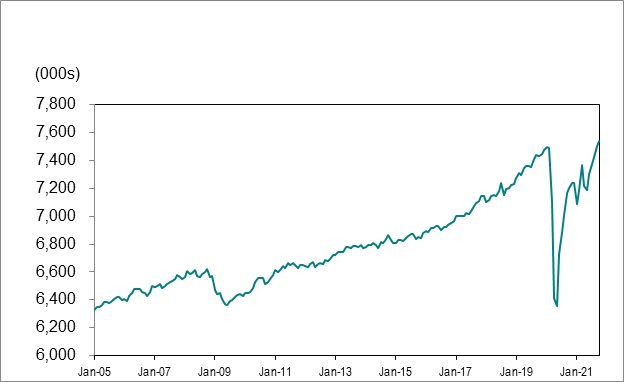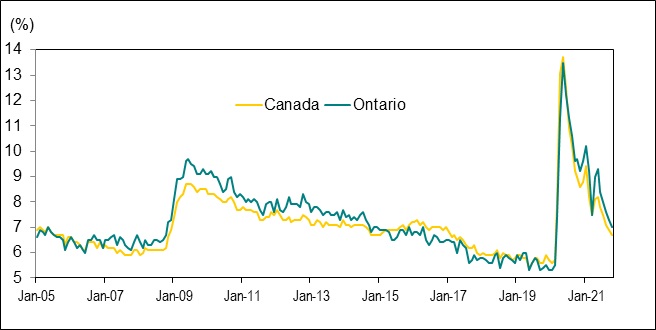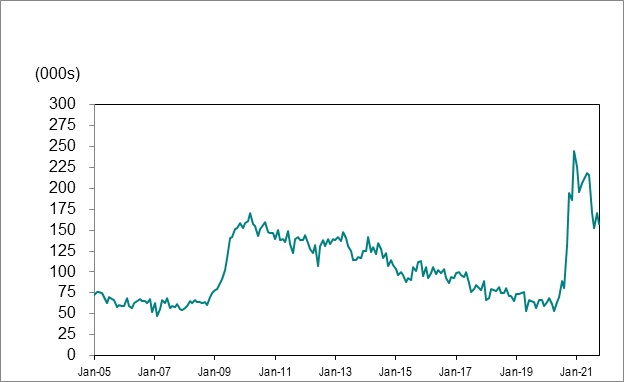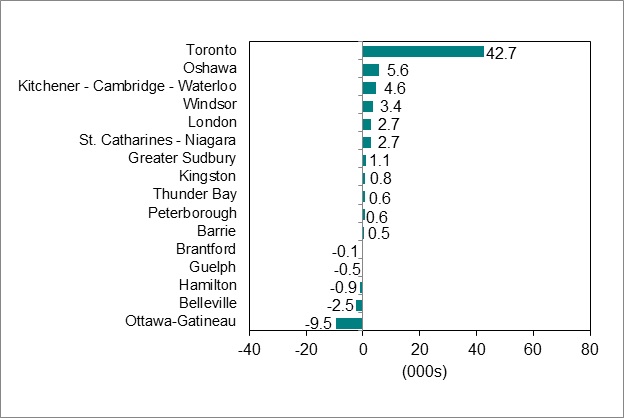Labour market report, October 2021
Employment in Ontario increased by 37,000 in October. Get the details in this report.
Quick facts
In October 2021:
- There were 12.4 million people in Ontario aged 15 years or older
- 8.1 million (65.4%) were in the labour force. The labour force increased in October (13,200 or 0.2%) compared to September.
- 7.5 million (60.9%) were employed, up by 37,000 (0.5%) from September.
- Ontario's unemployment rate decreased to 7.0% in October from 7.3% in September and 567,900 people were unemployed, down 4.0% (-23,700) from September
Important note:
This report is based on the Labour Force Survey (LFS), a household survey carried out by Statistics Canada. October’s LFS results cover labour market conditions during the week of October 10 to 16.
Ontario’s mandatory closure of non-essential businesses and other measures aimed at addressing the impact of COVID-19 took effect on March 24, 2020.
The types of businesses that were deemed essential and remained open during the COVID-19 economic shutdown and the types of businesses that reopened at the different stages of the Ontario government’s plan for reopening the economy should be considered in the context of information provided in this report.
On September 25, capacity limits were increased in many indoor venues (e.g., movie theatres and concert venues) where proof of vaccination is required, as well as in certain outdoor event venues.
Compared with the September reference week, more proof-of-vaccination initiatives were in effect in Ontario and capacity limits were lifted in many venues where proof of vaccination is now mandatory.
Employment increased in October
Employment in Ontario increased for the fifth consecutive month in October (37,000 or 0.5%), following an increase of 73,600 (1.0%) in September.
In October, employment in Ontario was 45,600 (0.6%) above its pre-COVID-19 February 2020 level.
Chart 1 shows employment in Ontario from January 2005 to October 2021.

Source: Statistics Canada, Labour Force Survey, Table 14-10-0287-01, (seasonally adjusted data).
Full-time vs. part-time
Part-time jobs (42,300 or 3.2%) accounted for all of the employment increase in October. Full-time jobs (-5,400 or -0.1%) decreased.
Employment change by sex and age
October’s employment increase was 46,200 (1.2%) for men, while employment for women declined (-9,300 or -0.3%). Employment among men was 0.8% (32,100) above its pre-COVID February 2020 level and employment among women was 0.4% (13,500) above.
Youth (ages 15-24) employment increased by 18,100 (1.8%) in October, following similar gains in September (18,800 or 1.9%). Employment for people aged 25 to 54 increased by 18,100 (0.4%) in October, following an increase of 53,700 (1.1%) in September. Employment for those aged 55 and older was unchanged in October compared to September.
In October, youth employment was ahead (0.9% or 9,000) of its pre-COVID February 2020 level for the first time. Employment among those aged 25-54 was above its pre-COVID February 2020 level by 1.4% (66,600), while employment among those aged 55 and over was 1.8% (-30,000) below.
Employment in Canada increased by 31,200 (0.2%) in October after increasing by 157,100 (0.8%) in September and surpassing its pre-COVID February 2020 level.
Employment change by industry
The government’s restrictions on the types of businesses that were deemed essential and other measures aimed at addressing the impact of COVID-19 should be considered in the context of employment change by sector.
Wholesale and retail trade (46,400 or 4.3%), other services (17,300 or 6.7%) and information, culture and recreation (10,200 or 3.1%) led job gains in October. Educational services (-12,400 or -2.2%), public administration (-11,800 or -2.8%), professional, scientific and technical services (-11,400 or -1.5%) and health care and social assistance (-11,400 or -1.2%) had the most net employment losses.
In October, nine of the 16 major industry groups had employment levels that were above pre-COVID February 2020 levels, led by professional, scientific and technical services (87,400 or 13.0%), information, culture and recreation (39,800 or 13.2%) and public administration (22,200 or 5.7%).
Employment in accommodation and food services (-40,100 or -9.1%) was furthest below its pre-COVID February 2020 level, followed by business, building and other services (-34,700 or -10.7%) and construction (-32,800 or -5.8%).
Chart 2 shows industries by employment change in Ontario, February 2020 to October 2021.

Source: Statistics Canada, Labour Force Survey, Table 14-10-0355-02, (seasonally adjusted data).
Unemployment rate decreased to 7.0 %
Chart 3 shows unemployment rates, Ontario and Canada, January 2005 to October 2021.

Source: Statistics Canada, Labour Force Survey, Table 14-10-0287-01, (seasonally adjusted data).
Ontario’s unemployment rate in October was 7.0%, down from 7.3% in September and was at its lowest rate since February 2020 (5.5%).
Canada’s unemployment rate fell to 6.7% in October from 6.9% in September. Canada’s unemployment rate in February 2020 was 5.7%.
Unemployment rate by sex and age
The unemployment rate for women was 7.0% in October, up from 6.8% in September, while the rate for men fell to 7.0% from 7.8% during the same period.
In Ontario, the unemployment rate among population groups designated as visible minorities was estimated at 9.0% in October in comparison to a 4.8% rate for non-visible minorities and those that did not identify as Indigenous (data are for the population aged 15 to 69 and are not adjusted for seasonality).
For individuals aged 15 to 24, the unemployment rate decreased to 9.9% in October from 12.5% in September. This was the lowest youth unemployment rated recorded in Ontario since June 1990 (8.5%). The youth unemployment rate reached a record high of 30.0% in May 2020.
The unemployment rate for individuals aged 25 to 54 was 6.3% in October, down from 6.4% in September, while the rate for those aged 55 and older increased to 7.2% from 6.6%.
Long-term unemployment
In October, an average of 157,100 Ontarians or 27.7% of all unemployed people were unemployed for 27 weeks or longer (long-term unemployed). This was down from 169,800 or 28.7% in September and more than two times the pre-COVID February 2020 level of 68,800.
The average time in unemployment was 24.1 weeks in October 2021 compared to 15.9 weeks in February 2020.
Chart 4 shows the number of people unemployed for 27 weeks or more in Ontario, January 2005 to October 2021.

Source: Statistics Canada, Labour Force Survey, Table 14-10-0342-01, (seasonally adjusted data).
Employment and unemployment in urban centres
Employment change in urban centres
Chart 5 shows employment change for Ontario Census Metropolitan Areas (CMAs) from September 2021 to October 2021.

Source: Statistics Canada, Labour Force Survey, Table 14-10-0380-01, (seasonally adjusted data three-month moving average to reduce volatility caused by small sample size).
Toronto (42,700 or 1.2%) led employment gains among the sixteen Ontario Census Metropolitan Areas (CMAs) between September and October, followed by Oshawa (5,600 or 2.6%) and Kitchener-Cambridge-Waterloos (4,600 or 1.4%). The employment level notably fell in Ottawa-Gatineau (Ontario part) (-9,500 or -1.6%) and Belleville (-2,500 or -5.0%).
In October, employment in most of the 16 Ontario CMAs was close to or above pre-COVID February 2020 levels, led by Toronto (43,200 or 1.2%), London (14,800 or 5.5%) and Guelph (7,800 or 9.0%).
Ottawa-Gatineau (-12,600 or -2.1%), Belleville (-10,200 or -17.5%), Kitchener-Cambridge-Waterloo (-7,800 or -2.3%) and Barrie (-7,300 or -5.8%) reported employment estimates that were notably below pre-COVID February 2020 levels.
Lowest and highest unemployment rates in urban centres
Chart 6 shows Census Metropolitan Areas (CMAs) with highest and lowest unemployment rates in Canada, October 2021.

Source: Statistics Canada, Labour Force Survey, Table 14-10-0380-02, (seasonally adjusted data three-month moving average to reduce volatility caused by small sample size).
Windsor recorded the highest unemployment rate in Canada in October (9.2%), followed by Toronto (8.4%).
Guelph recorded the lowest unemployment rate in Ontario in October (5.1%), while Quebec City recorded the lowest unemployment rate in Canada (3.8%).
Download data
Source: Statistics Canada, Labour Force Survey
July 2021 Labour Market Report:
- CSV, Chart 1, employment in Ontario from January 2005 to October 2021, 1Kb
- CSV, Chart 2, industries with highest and lowest employment change in Ontario, February 2020 to October 2021, 2Kb
- CSV, Chart 3, unemployment rates, Ontario and Canada, January 2005 to October 2021, 2Kb
- CSV, Chart 4, number of people unemployed for 27 week or more in Ontario, January 2005 to October 2021, 2Kb
- CSV, Chart 5, employment change for Ontario Census Metropolitan Areas (CMAs) from September 2021 to October 2021, 2Kb
- CSV, Chart 6, Census Metropolitan Areas (CMAs) highest and lowest unemployment rates, October 2021, 2Kb